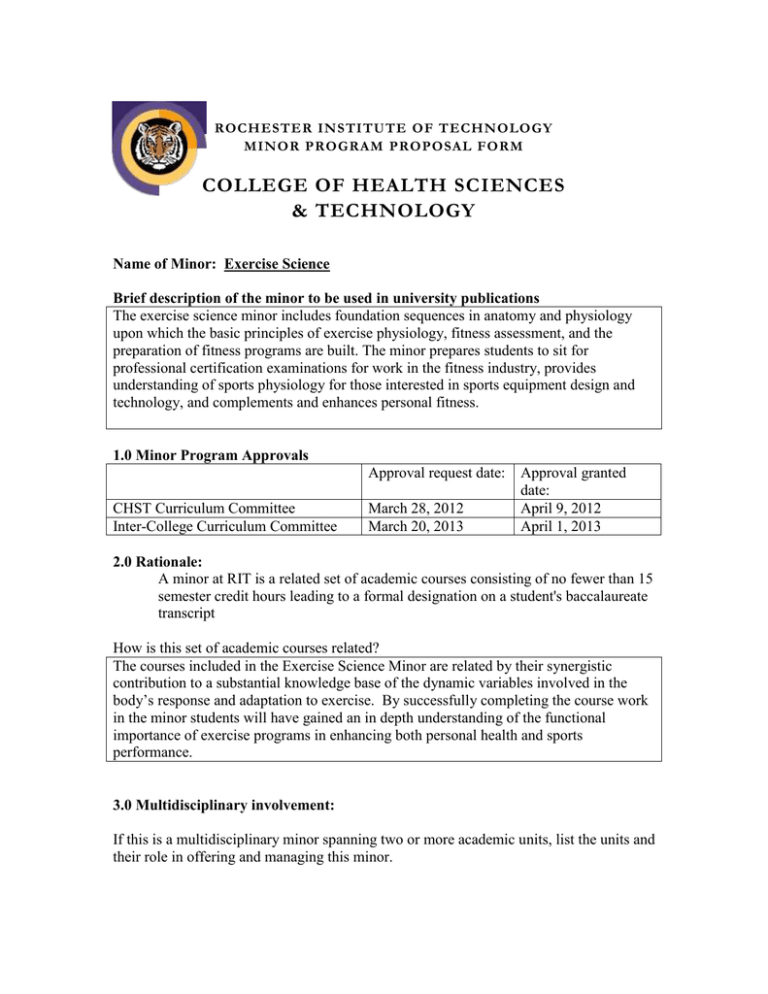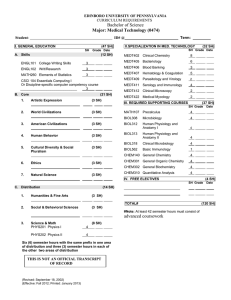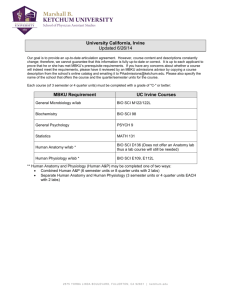Exercise Science
advertisement

ROCHESTER INSTITUTE OF TECHNOLOGY MINOR PROGRAM PROPOSAL FORM COLLEGE OF HEALTH SCIENCES & TECHNOLOGY Name of Minor: Exercise Science Brief description of the minor to be used in university publications The exercise science minor includes foundation sequences in anatomy and physiology upon which the basic principles of exercise physiology, fitness assessment, and the preparation of fitness programs are built. The minor prepares students to sit for professional certification examinations for work in the fitness industry, provides understanding of sports physiology for those interested in sports equipment design and technology, and complements and enhances personal fitness. 1.0 Minor Program Approvals Approval request date: CHST Curriculum Committee Inter-College Curriculum Committee March 28, 2012 March 20, 2013 Approval granted date: April 9, 2012 April 1, 2013 2.0 Rationale: A minor at RIT is a related set of academic courses consisting of no fewer than 15 semester credit hours leading to a formal designation on a student's baccalaureate transcript How is this set of academic courses related? The courses included in the Exercise Science Minor are related by their synergistic contribution to a substantial knowledge base of the dynamic variables involved in the body’s response and adaptation to exercise. By successfully completing the course work in the minor students will have gained an in depth understanding of the functional importance of exercise programs in enhancing both personal health and sports performance. 3.0 Multidisciplinary involvement: If this is a multidisciplinary minor spanning two or more academic units, list the units and their role in offering and managing this minor. Sports Nutrition is included in the minor and offered through the Nutrition Management program. Exercise Science and Nutrition Management will work cooperatively to insure the successful integration of the Sports Nutrition course into the Exercise Science Minor. CHST does not have departments. The Biomedical Sciences Program will manage the Exercise Science Minor and have the responsibility for certifying its completion of the for commencement. 4.0 Students ineligible to pursue this minor: The purpose of the minor is both to broaden a student's college education and deepen it in an area outside the student’s major program. A minor may be related to and complement a student’s major, or it may be in a completely different academic/professional area. It is the responsibility of the academic unit proposing a minor and the unit’s curriculum committee to indicate any home programs for which the minor is not a broadening experience. Please list below any home programs whose students will not be allowed to pursue this minor, provide the reasoning, and indicate if this exclusion has been discussed with the affected programs: Students enrolled in the Biomedical Sciences who have declared a concentration in Exercise Science would be ineligible to utilize Exercise Science as a Minor. The Biomedical Sciences program is aware of this clarification of eligibility. 5.0 Minor Program Structure, Sequence and Course Offering Schedule: Describe the structure of the proposed minor and list all courses, their anticipated offering schedule, and any prerequisites. All minors must contain at least fifteen semester credit hours; Minors may be discipline-based or interdisciplinary; In most cases, minors shall consist of a minimum of two upper division courses (300 or above) to provide reasonable breadth and depth within the minor; As per New York State requirements, courses within the minor must be offered with sufficient frequency to allow students to complete the minor within the same time frame allowed for the completion of the baccalaureate degree; Provide a program mask showing how students will complete the minor. Narrative of Minor Program Structure: The Exercise Science Minor is structured to allow students interested in both clinical applications of exercise as well as athletic conditioning to explore the topics by selecting courses that fulfill their intellectual curiosity. Students must choose five of the following courses. Course Number & Title MEDS-250 Anatomy & Physiology I SCH Required Optional Fall 4 X X Spring Annual/ Biennial Annual Prerequisites BIOL-101 & 102 Gen. Bio 2 MEDS-251 Anatomy & Physiology II 4 X MEDS-295 Sports Physiology & Life Fitness MEDS-296 Fitness Prescription MEDS-297 Exercise for Special Populations MEDS-350 Exercise Physiology MEDS-298 Strength Training for Performance MEDS-413 Training the High Performance Athlete MEDS-407 Prevention and Treatment of Athletic Injuries MEDS-410 Kinesiology 3 X 3 X 3 X 3 X 3 X 3 X X Biennial One Year of College Biology 3 X X Biennial One Year of College Biology 3 X Annual NUTR-300 Sports Nutrition 3 X MEDS-251 Anatomy & Physiology II One Year of College Biology or NUTR-125 Contemp. X X Annual X Annual X Annual Or BIOL-121 & 122 Intro. Bio BIOL-101 & 102 Gen. Bio Or BIOL-121 & 122 Intro. Bio One Year of College Biology X Annual X X Annual Annual X X Annual One Year of College Biology One Year of College Biology MEDS-251 Anatomy & Physiology II One Year of College Biology 3 Nutrition Total credit hours: 15-17 Minor Course Conversion Table: Quarter Calendar and Semester Calendar Comparison Directions: The tables on this page will be used by the registrar’s office to aid student’s transitioning from the quarter calendar to the semester calendar. If this minor existed in the quarter calendar and is being converted to the semester calendar please complete the following tables. If this is a new minor that did not exist under the quarter calendar do not complete the following tables. Use the following tables to show minor course comparison in quarter and semester calendar formats. Use courses in the (2011-12) minor mask for this table. Display all required and elective minor courses. If necessary clarify how course sequences in the quarter calendar convert to semesters by either bracketing or using some other notation. Name of Minor in Semester Calendar: Name of Minor in Quarter Calendar: Name of Certifying Academic Unit: Exercise Science Exercise Science College of Health Sciences and Technology QUARTER: Current Minor Courses Course Course QCH # Title SEMESTER: Converted Minor Courses Course Course SCH # Title 1026350 1026360 Anatomy & Physiology I Anatomy & Physiology II 5 MEDS250 MEDS251 1026305 Sports Physiology & Life Fitness 4 MEDS295 1026306 Fitness Prescription& Programming Exercise Prescription for Special Populations Sports Nutrition Exercise 4 MEDS296 4 4 1026307 0620300 1026- 5 4 Anatomy & Physiology I Anatomy & Physiology II Sports Physiology & Life Fitness Fitness Prescription 4 MEDS297 Exercise for Special Populations 3 NUTR300 MEDS- Sports Nutrition Exercise 3 Comments 4 3 3 3 4 QUARTER: Current Minor Courses 559 1026559 1026559 1026559 1026559 Physiology Strength Training for Performance Training the High Performance Athlete Prevention and Treatment of Athletic Injuries Kinesiology 4 SEMESTER: Converted Minor Courses 350 MEDS298 4 MEDS413 4 MEDS407 4 MEDS407 Physiology Strength Training for Performance Training the High Performance Athlete Prevention and Treatment of Athletic Injuries Kinesiology 3 3 3 3 5 Policy Name: D1.1 MINORS POLICY 1. Definition A minor at RIT is a related set of academic courses consisting of no fewer than 15 semester credit hours leading to a formal designation on a student's baccalaureate transcript. The purpose of the minor is both to broaden a student's college education and deepen it in an area outside the student’s major program. A minor may be related to and complement a student’s major, or it may be in a completely different academic/professional area. It is the responsibility of the academic unit proposing a minor and the unit’s curriculum committee to indicate any home programs for which the minor is not a broadening experience. In most cases, minors shall consist of a minimum of two upper division courses to provide reasonable breadth and depth within the minor. 2. Institutional parameters a) Minors may be discipline-based or interdisciplinary; b) Only matriculated students may enroll in a minor; c) At least nine semester credit hours of the minor must consist of courses not required by the student's home program; d) Students may pursue multiple minors. A minimum of nine semester credit hours must be designated towards each minor; these courses may not be counted towards other minors; e) The residency requirement for a minor is a minimum of nine semester credit hours consisting of RIT courses (excluding "X" graded courses); f) Posting of the minor on the student's academic transcript requires a minimum GPA of 2.0 in each of the minor courses; g) Minors may not be added to the student's academic record after the granting of the bachelor's degree. 6 3. Development/approval/administration processes a. Minors may be developed by faculty at the departmental, inter-departmental, college, or inter-college level. As part of the minor development process: i. students ineligible for the proposed minor will be identified; ii. prerequisites, if any, will be identified; b. Minor proposals must be approved by the appropriate academic unit(s) curriculum committee, and college curriculum committee(s), before being sent to the Inter-College Curriculum Committee (ICC) for final consideration and approval. c. The academic unit offering the minor (in the case of interdisciplinary minors, the designated college/department) is responsible for the following: i. enrolling students in the minor (as space permits); ii. monitoring students progress toward completion of the minor; iii. authorizing the recording of the minor's completion on student's academic records; iv. granting of transfer credit, credit by exam, credit by experience, course substitutions, and advanced placement; v. responding to student requests for removal from the minor. d. As per New York State requirements, courses within the minor must be offered with sufficient frequency to allow students to complete the minor within the same time frame allowed for the completion of the baccalaureate degree. 4. Procedures for Minor revision It is the duty of the college curriculum committee(s) involved with a minor to maintain the program’s structure and coherence. Once a minor is approved by the ICC, changes to the minor that do not have a significant effect on its focus may be completed with the approval of the involved academic unit(s) and the college curriculum committee(s). Significant changes in the focus of the minor must be approved by the appropriate academic unit(s) curriculum committee(s), the college curriculum committee(s) and be resubmitted to the ICC for final consideration and approval. 7



